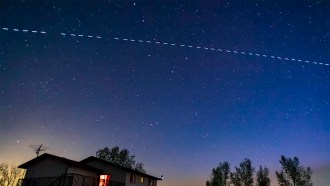Space
-
 Astronomy
AstronomyRunaway stars could influence the cosmos far past their home galaxies
Dozens of stars fleeing a neighbor of the Milky Way suggest these escapees could have an outsized influence on their cosmic surroundings.
-
 Planetary Science
Planetary ScienceEuropa Clipper has launched to solve an alien mystery
Launched October 14, the spacecraft will repeatedly buzz Europa in search of water, energy and organic compounds.
-
 Space
Space50 years ago, satellites threatened astronomers’ view of the cosmos
As satellite launches ramp up and the spacecraft clog the skies, astronomers fear for their data.
-
 Astronomy
AstronomyBarnard’s star has at least one planet orbiting it after all
After decades of searching, a telltale gravitational wobble points to an exoplanet orbiting the nearby red dwarf every 3.15 days.
By Sid Perkins -
 Astronomy
AstronomyBetelgeuse has a tiny companion star hidden in plain sight
Betelgeuse has a sequel — in the form of a companion star that's about the same mass as the sun, orbiting it about once every 2,100 days.
-
 Astronomy
AstronomyStarlink satellites’ leaky radio waves obscure the cosmos
Starlink satellites unintentionally emit radio waves that appear more than 10 million times brighter than natural sources, as seen by ground-based radio telescopes.
By Sid Perkins -
 Physics
PhysicsX-rays from nuclear blasts could defend Earth from asteroids
The X-ray pulses could deflect asteroids up to 4 kilometers wide, a new study suggests.
By Nikk Ogasa -
 Cosmology
CosmologyHow did dark matter shape the universe? This physicist has ideas
Theoretical physicist Tracy Slatyer proposes new scenarios for dark matter and helped discover the Fermi bubbles.
By Adam Mann -
 Particle Physics
Particle PhysicsA neutrino mass mismatch could shake cosmology’s foundations
Cosmological data suggest unexpected masses for neutrinos, including the possibility of zero or negative mass.
-
 Space
SpaceMeet Porphyrion, the largest pair of black hole jets ever seen
The two plasma fountains, spanning 23 million light-years, could shape cosmic structures far beyond their home galaxy.
-
 Physics
PhysicsHow to spot tiny black holes that might pass through the solar system
Flybys of primordial black holes may occur once a decade. Tweaks to the orbits of planets and GPS satellites could give away their presence.
-
 Space
SpaceHow a dying star is similar to a lava lamp
In a first, astronomers captured how convective forces power the quick bubbling movement of gas cells on the surface of a distant, massive star.